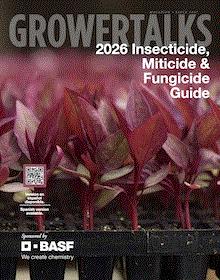What’s Happening Here?
Growing plants can be very humbling. I usually consider hosta to be a low-maintenance and carefree crop. However, there are a few issues that can arise on occasion. Take a look at these hosta:
Holy unmarketable plants, Batman! I think you’d agree, these hosta look horrible. The question is do you know “What’s happening here?” Contemplate the possibilities and I'll reveal the cause in a few minutes.
Download the 2026 IMF Guide

The 2026 version of
GrowerTalks' Insect, Miticide & Fungicide Guide is now available. This resource has become a grower’s favorite feature and tool they use throughout the entire year. I invite you to download your very own FREE copy of the
2026 Insecticide, Miticide & Fungicide Guide.
The newest edition contains tons of content, including chemical class charts, an extensive insecticide/miticide table and numerous articles from several of the industry’s top experts. Curious, but not quite ready to hit the download link above? How about I give you a glimpse of what’s inside the guide?
Designing Programs
-
Building Better Fungicide Programs: Balanced Plant Protection Solutions
-
Building Better Insecticide Programs: Basic Rotations + Functional Glow Up
Informative Charts and Tables
-
Chemical Class Chart for Greenhouse Nursery Fungicides
-
2026 Insecticides and Miticides for Managing Insect and Mite Pests of Greenhouse Grown Horticultural Crops—Raymond A. Cloyd, Department of Entomology Kansas State University
Excellent Articles From Industry Experts
-
Guarding Against Fusarium: Best Practices for Growers—David James Norman, Ph. D., University of Florida Mid Florida Research and Education Center
-
Dedication, Passion & Innovation: What drives Casey Marshall and Tom Dodd Nurseries
-
The IPM Decision Tree: Basic Rotations to Build On; add functional groups that work for your operation—Jennifer Browning PCA, BASF Senior Technical Specialist
-
Field Guide to Thrips in Ornamentals: A Focus on Thrips parvispinus—Zee Ahmed, Ph.D., Clemson University
-
Use of Rice Hulls and Preemergence Herbicides for Improving Container Nursery Weed Control—Chris Marble, Ph. D., University of Florida Mid Florida Research and Education Center
-
Rotate & Re-Apply: Preemergent Herbicides for Nursery Weed Control—Chris Marble, Ph. D., University of Florida Mid Florida Research and Education Center
I’d like to give a great big THANK YOU to BASF for sponsoring and making the 2026 IMF Guide possible. Muchas gracias! That reminds me—the guide is also available in Spanish.

UConn Native Plants & Pollinators Conference

When: November 13, 2025: 8:45 a.m. to 3:15 p.m.
Where: Student Union Ballroom (Room 330), 2100 Hillside Road, Storrs, CT 06269
Session topics:
-
Who are Connecticut’s Specialist Bees—Tracy Zarillo MS., Connecticut Agricultural Experiment Station
-
Soil Microbial Allies in Managed Systems—Mia Maltz, PhD., Assistant Professor, University of Connecticut
-
Knockout Natives—Sam Hoadley, Mt. Cuba Center Botanic Garden
-
Seeing Nature—Andrew Brand, MS., Coastal Maine Botanical Garden
-
Native Landscape Plants with Local Roots—Jessica Lubell-Brand, PhD., Professor, University of Connecticut
Cost: There's a nominal $70 cost to attend for early registrants (by October 15, 2025) or $80 for those procrastinators like me (after October 15). Special pricing is available to college/university matriculated students with valid school ID (only $25).
Besides the great information from these awesome sessions, the registration fee includes continental breakfast, lunch, refreshments and pesticide recertification credits.

The Answer is ...

I showed this image of hosta at the top of the newsletter, which I think it’s safe to say looks pretty darn bad. I asked if you knew what was going on. The answer is probably obvious; they have a horrible case of leaf spots.
I’m not a pathologist (nor do I play one on TV), but these are fungal leaf spots. Hosta are susceptible to several leaf spot diseases, but Colletotrichum (Anthracnose) and Cercospora are the most common leaf spot pathogens observed on hosta. It’s also not uncommon for more than one foliar pathogen to be present at a time.
Why and What Can Be Done About It?
Unless you're a plant pathologist, I think we all agree that the hosta in this week's challenge look pretty bad, but do you know why they look this way? The answer is wet leaves. Foliar leaf spot diseases will only occur when the leaves are wet for long durations.
There are a number of ways this can happen—early morning irrigations, watering multiple times each day, watering during cloudy conditions, extended periods of rain and even dew events. In most cases, I find it’s a combination of watering too early in the day in conjuction with watering during cloudy conditions.
Cercospora. Credit: Hosta Diseases and Pests—Sustainable Urban Landscapes. Click HERE to download this informative guide for FREE.)
Foliar leaf spots on hostas can generally be prevented altogether simply by managing (decreasing) the time the leaves stay wet. Water later in the day to allow the leaves to dry quickly, avoid late day irrigations and don't water during cloudy conditions.
There are a number of effective fungicides that can be applied on a preventative basis. Orkestra, Spectro 90 and Postiva are some of my favorites for these preventative applications. Fungicides are most effective when applied before or just as foliar pathogens are observed.
If you observed foliar leaf spots this summer, there's a greater chance they'll also occur next year several weeks after the plants wake up from dormancy. If you see leaf spots this fall, I highly recommend you make a couple of fungicide applications after the hostas wake up next year. The first application should be just after the leaves are fully expanded and again three to four weeks later. This should get you through spring shipping or sales.





My email is ppilon@ballpublishing.com if you have any comments, article suggestions or if you'd just like to say hello.
Best regards,

Paul Pilon
Editor-at-Large—Perennial Pulse
This email was received by you and 34,140 other fine subscribers!
If you're interested in advertising in Perennial Pulse, contact Kim Brown ASAP and she'll hook you up.